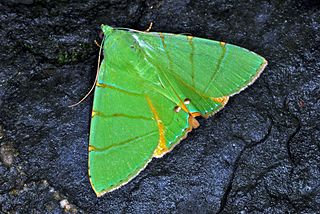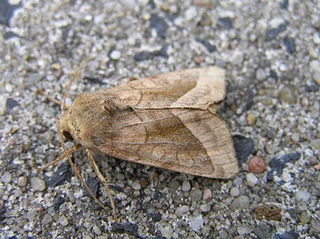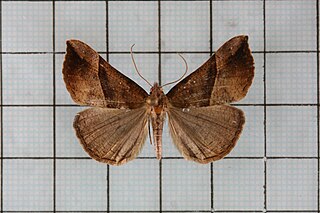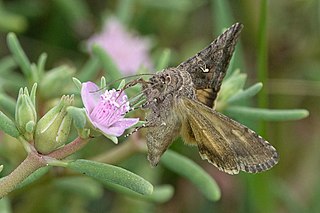| Rachiplusia | |
|---|---|
 | |
| Rachiplusia ou | |
| Scientific classification | |
| Domain: | Eukaryota |
| Kingdom: | Animalia |
| Phylum: | Arthropoda |
| Class: | Insecta |
| Order: | Lepidoptera |
| Superfamily: | Noctuoidea |
| Family: | Noctuidae |
| Subtribe: | Autoplusiina |
| Genus: | Rachiplusia Hampson, 1913 |
| Rachiplusia | |
|---|---|
 | |
| Rachiplusia ou | |
| Scientific classification | |
| Domain: | Eukaryota |
| Kingdom: | Animalia |
| Phylum: | Arthropoda |
| Class: | Insecta |
| Order: | Lepidoptera |
| Superfamily: | Noctuoidea |
| Family: | Noctuidae |
| Subtribe: | Autoplusiina |
| Genus: | Rachiplusia Hampson, 1913 |

The Noctuidae, commonly known as owlet moths, cutworms or armyworms, are a family of moths. They are considered the most controversial family in the superfamily Noctuoidea because many of the clades are constantly changing, along with the other families of the Noctuoidea. It was considered the largest family in Lepidoptera for a long time, but after regrouping Lymantriinae, Catocalinae and Calpinae within the family Erebidae, the latter holds this title now. Currently, Noctuidae is the second largest family in Noctuoidea, with about 1,089 genera and 11,772 species. This classification is still contingent, as more changes continue to appear between Noctuidae and Erebidae.

Noctuoidea is the superfamily of noctuid or "owlet" moths, and has more than 70,000 described species, the largest number of any Lepidopteran superfamily. Its classification has not yet reached a satisfactory or stable state. Since the end of the 20th century, increasing availability of molecular phylogenetic data for this hugely successful radiation has led to several competing proposals for a taxonomic arrangement that correctly represents the relationships between the major lineages.

Acronicta is a genus of noctuid moths containing about 150 species distributed mainly in the temperate Holarctic, with some in adjacent subtropical regions. The genus was erected by Carl Linnaeus in his 1758 10th edition of Systema Naturae. Caterpillars of most Acronicta species are unmistakable, with brightly colored hairy spikes, and often feed quite visibly on common foliate trees. The hairy spikes may contain poison, which cause itchy, painful, swollen rash in humans on contact. The larva of the smeared dagger moth is unusually hairy even for this genus. Acronicta species are generally known as dagger moths, as most have one or more black dagger-shaped markings on their forewing uppersides. But some species have a conspicuous dark ring marking instead.

Agrapha is a genus of moths of the family Noctuidae erected by Jacob Hübner in 1821.

Celiptera is a genus of moths in the family Erebidae.

Condica is a genus of moths of the family Noctuidae. The genus was erected by Francis Walker in 1856.

Isogona is a genus of moths of the family Erebidae. The genus was erected by Achille Guenée in 1852.

Entomogramma is a genus of moths of the family Noctuidae. The genus was erected by Achille Guenée in 1852.
Ephyrodes is a genus of moths in the family Erebidae. The genus was introduced by Achille Guenée in 1852.

Eulepidotis is a genus of moths of the family Erebidae erected by Jacob Hübner in 1823.

Hydraecia is a genus of moths of the family Noctuidae.

Hypospila is a genus of moths in the family Erebidae. The genus was erected by Achille Guenée in 1852.

Hypotrix is a genus of moths of the family Noctuidae.

Mocis is a genus of moths in the family Erebidae. The genus was erected by Jacob Hübner in 1823.

Paectes is a genus of moths of the family Euteliidae erected by Jacob Hübner in 1818.

Praxis is a genus of moths of the family Noctuidae. The genus was erected by Achille Guenée in 1852.

Spodoptera is a genus of moths of the family Noctuidae erected by Achille Guenée in 1852. Many are known as pest insects. The larvae are sometimes called armyworms. The roughly thirty species are distributed across six continents.

Rachiplusia ou, commonly known as the gray looper moth, is a species of moth in the family Noctuidae. The species was first described by Achille Guenée in 1852. It is found in the southern and eastern parts of the United States, Montana, Nova Scotia, from Mexico to Venezuela to Ecuador and the Dominican Republic.

Rachiplusia nu is a species of moth in the family Noctuidae. It is found in South America, including Paraguay, Uruguay, southern Brazil, Argentina and Chile.
Rachiplusia grisea is a species of moth of the family Noctuidae. It is found in South America, including Peru.